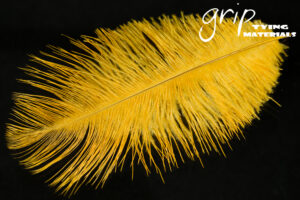Marabou is one of the most versatile and popular materials in fly tying, valued for…
Tying Flies Using Ostrich Feathers

Ostrich feathers are a versatile material in fly tying, known for their soft, wispy fibres that add lifelike movement and texture to flies. These feathers are most often used for building bodies, tails, or collars on a wide variety of patterns, including streamers, nymphs, and wet flies.
One of the primary advantages of ostrich fibres is their ability to mimic the undulating motion of aquatic insects and baitfish. The soft barbs pulse naturally in the water, making them particularly effective for creating realistic movement. For example, ostrich herl is frequently used in nymphs like the Prince Nymph or Hare’s Ear Nymph to form shaggy, textured bodies or legs. When used in streamers, such as the Zonker or Woolly Bugger, ostrich fibres add an extra element of attraction by enhancing the fly’s profile and imitating the erratic motion of prey.
Ostrich herl can also be wrapped around the hook shank to create bodies or thoraxes with a fuzzy, segmented appearance. These fibres are excellent substitutes for peacock herl when a softer or more subtle texture is desired. Additionally, dyed ostrich feathers provide a wide range of vibrant colours, offering creative opportunities for tying both traditional and modern patterns.

When tying with ostrich feathers, care must be taken to avoid breakage, as the fibres can be delicate. Reinforcing the herl with a thread or wire rib improves durability. A light touch when handling and tying the material ensures a neat and durable finish.
Whether used in subtle nymphs or bold streamers, ostrich feathers are a valuable addition to any fly tyer’s arsenal, offering a combination of movement, texture, and visual appeal that enhances a fly’s effectiveness.

